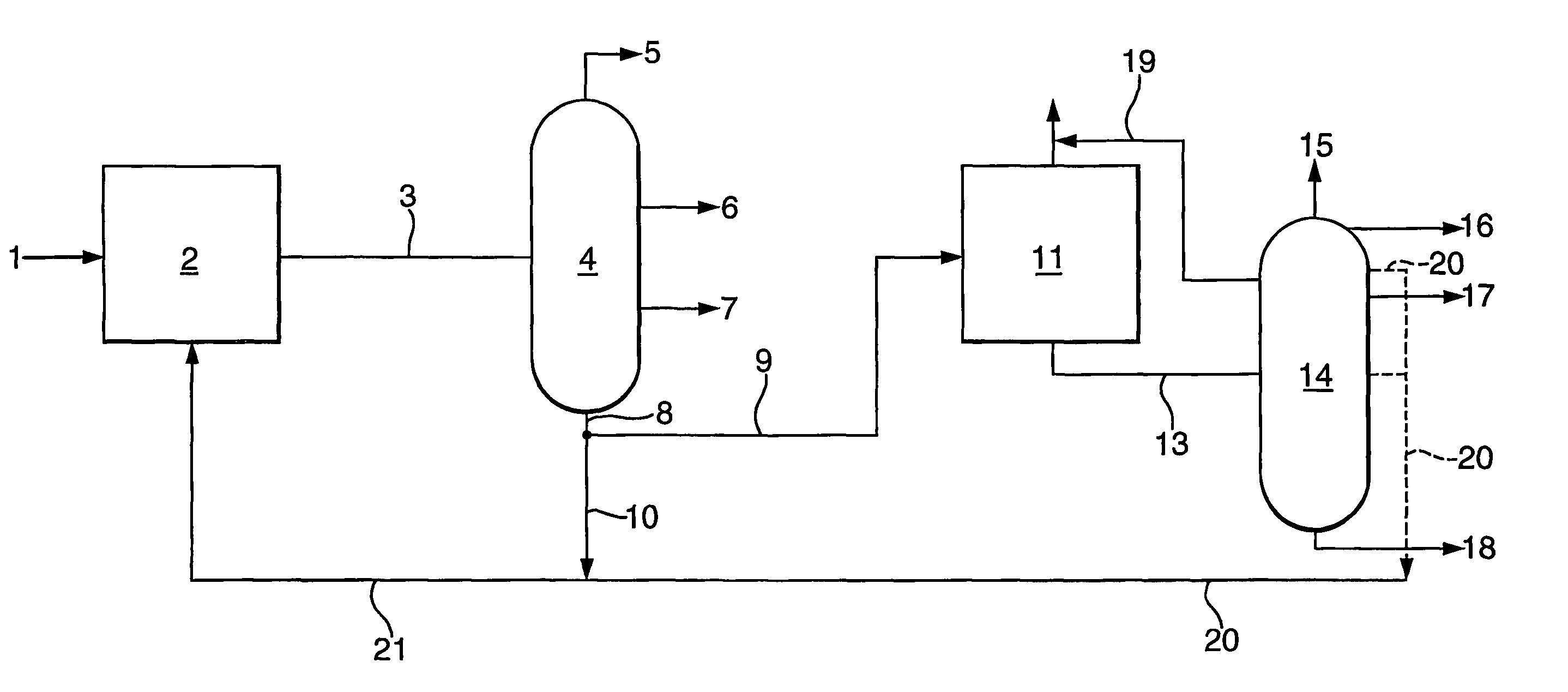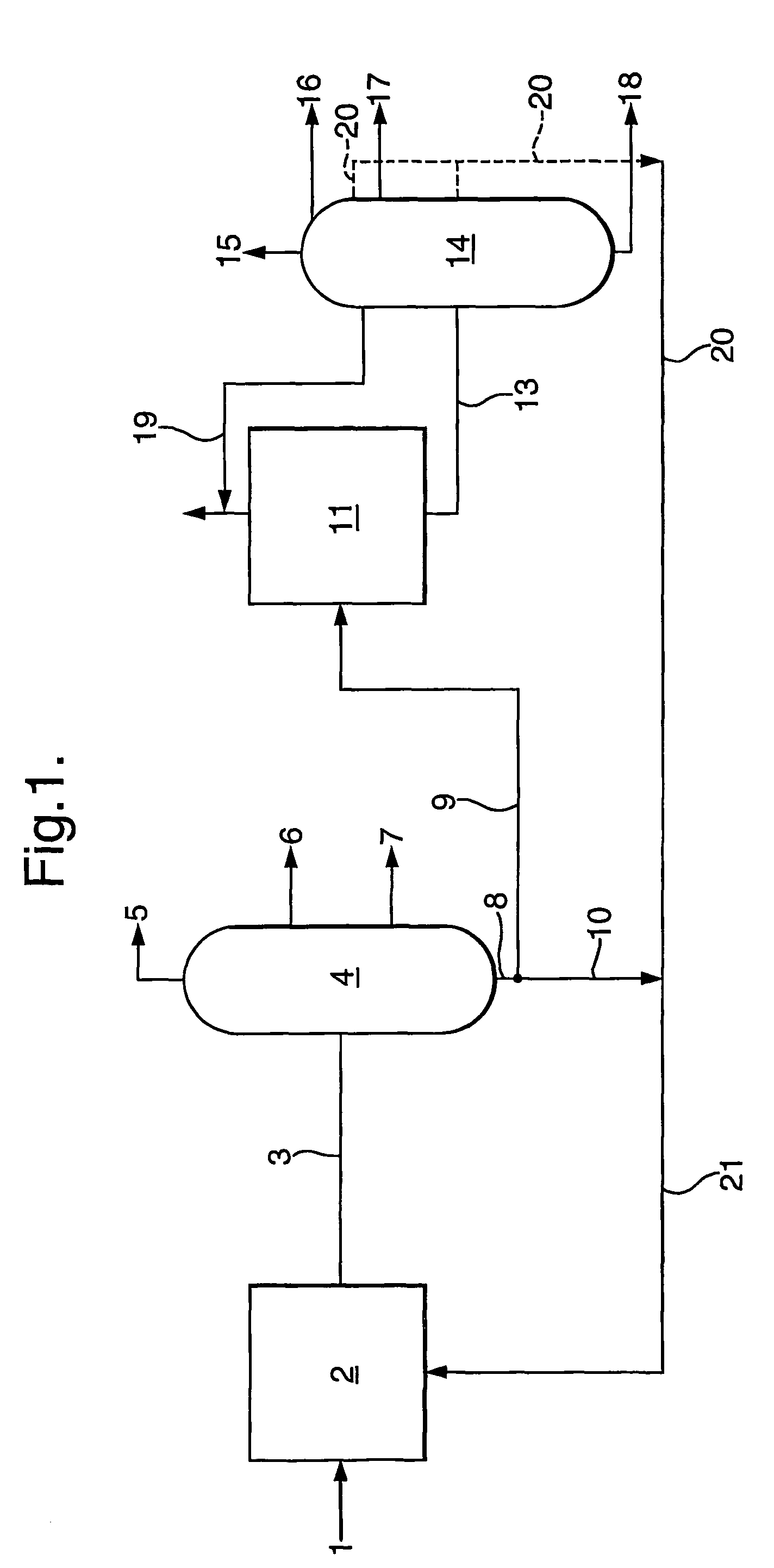Process to prepare a lubricating base oil and a gas oil
a technology of lubricating base oil and gas oil, which is applied in the direction of hydrocarbon oil cracking, hydrocarbon oil treatment products, lubricant composition, etc., can solve the problem of one grade of base oil preparation, and achieve the effect of high quality and high yield
- Summary
- Abstract
- Description
- Claims
- Application Information
AI Technical Summary
Benefits of technology
Problems solved by technology
Method used
Image
Examples
example 1
[0049]The C5-C750° C.+ fraction of the Fischer-Tropsch product, as obtained in Example VII using the catalyst of Example III of WO-A-9934917, was continuously fed to a hydrocracking step (step (a)). The feed contained about 60 wt % C30+ product. The ratio C60+ / C30+ was about 0.55. In the hydrocracking step the fraction was contacted with a hydrocracking catalyst of Example 1 of EP-A-532118. The effluent of step (a) was continuously distilled under vacuum to give lights, fuels and a residue “R” boiling from 370° C. and above. The yield of gas oil fraction on fresh feed to hydrocracking step was 43 wt %. The properties of the gas oil thus obtained are presented in Table 3.
[0050]The main part of the residue “R” was recycled to step (a) and a remaining part was sent to a catalytic dewaxing step (c). The conditions in the hydrocracking step (a) were: a fresh feed Weight Hourly Space Velocity (WHSV) of 0.8 kg / l.h, recycle feed WHSV of 0.25 kg / l.h, hydrogen gas rate=1000 Nl / kg, total press...
example 2
[0055]Example 1 was repeated except that the dewaxing temperature was 365° C. The dewaxed oil was distilled into three base oil fractions boiling between 305 and 420° C. (yield based on feed to dewaxing step was 16.1 wt %), between 420-510° C. (yield based on feed to dewaxing step was 16.1 wt %) and a fraction boiling above 510° C. (yield based on feed to dewaxing step was 27.9 wt %). The base oil fraction boiling between 420 and 510° C. and the heavier fraction was analysed in more detail (see Table 2).
[0056]
TABLE 2HeavyGrade 5Gradedensity at 20° C.818.5837.0pour point (° C.)−59+9kinematic viscosity at 40° C. (cSt)24.5kinematic viscosity at 100° C. (cSt)4.922.92VI128178sulphur content (% w)saturates (% w)>95
example 3-4
[0057]Example 1 was repeated except that the temperature in step (a) was varied (see Table 3). The gas oil fraction was further analysed (see Table 3). Cloud point, Pour point and CFPP were determined by ASTM D2500, ASTM D97 and IP 309-96 respectively. Establishment of the C5+, C30+ and C60+ fractions were done by gas chromatography.
PUM
| Property | Measurement | Unit |
|---|---|---|
| weight ratio | aaaaa | aaaaa |
| wt % | aaaaa | aaaaa |
| wt % | aaaaa | aaaaa |
Abstract
Description
Claims
Application Information
 Login to View More
Login to View More - R&D
- Intellectual Property
- Life Sciences
- Materials
- Tech Scout
- Unparalleled Data Quality
- Higher Quality Content
- 60% Fewer Hallucinations
Browse by: Latest US Patents, China's latest patents, Technical Efficacy Thesaurus, Application Domain, Technology Topic, Popular Technical Reports.
© 2025 PatSnap. All rights reserved.Legal|Privacy policy|Modern Slavery Act Transparency Statement|Sitemap|About US| Contact US: help@patsnap.com


